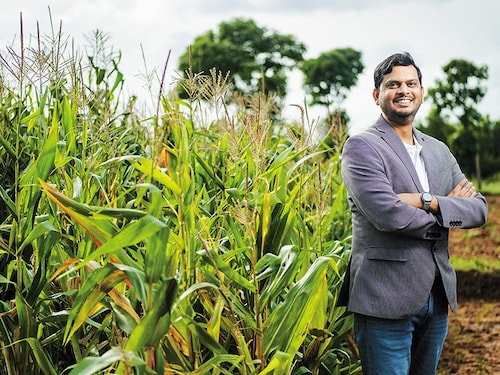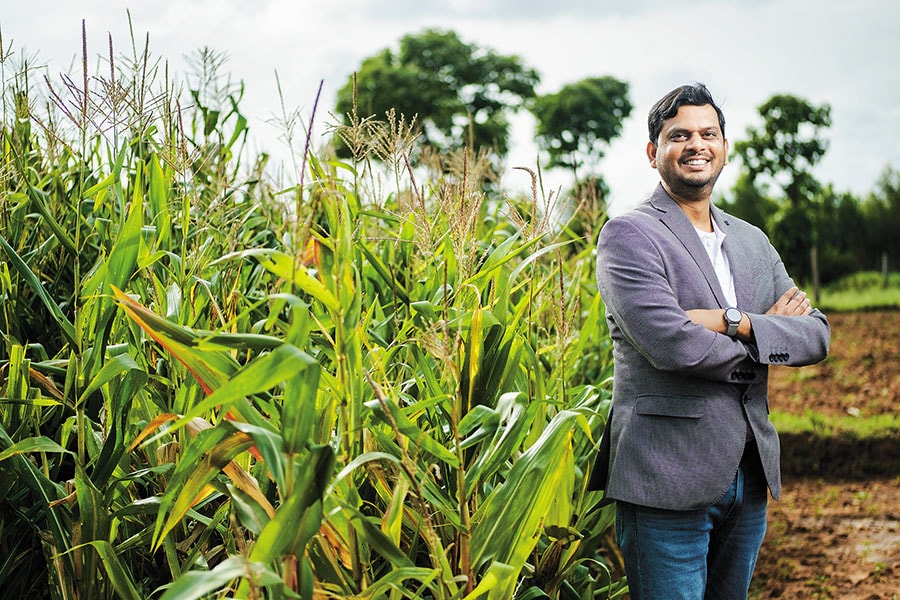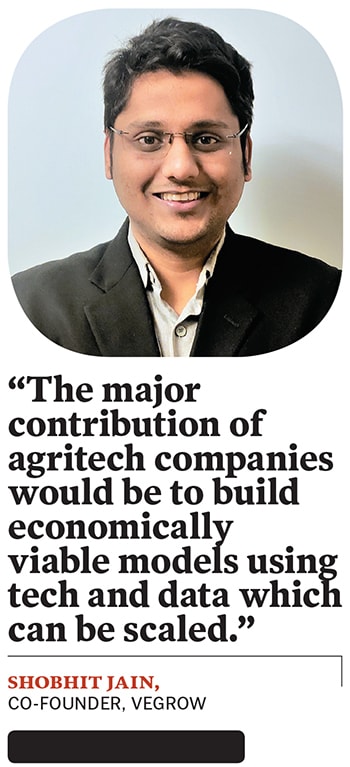Can agritech fix India's fragmented farm-to-fork supply chain?
A clutch of agritech startups and its VC backers are betting that it can be organised with technology, as agriculture begins a revival amid the pandemic


 Krishna Kumar, founder and CEO, CropIn Technology. The agritech startup provides real-time advisory for crops
Krishna Kumar, founder and CEO, CropIn Technology. The agritech startup provides real-time advisory for crops
Image: Nishant Ratnakar for Forbes India
Last month, Vegrow, an agritech startup focussed on aggregating small farms, raised $2.5 million in funding from Matrix Partners India, Ankur Capital and a few other venture capital (VC) and angel investors. The funding came at a time when the Bengaluru-based venture saw the beginning of a revival in the agriculture sector since Covid-19 began to spread in India. Vegrow is certain that even as people are coming to terms with the disruptions caused by the pandemic, bouncing back is just a matter of time.
The startup is now working to bring modern inputs and best practices to India’s agri sector to address multiple problems across the broken supply chain—from boosting production and timely finance to access to better markets. “We do see a lot of activity in the agri value chain across stakeholders,” says Shobhit Jain, co-founder of Vegrow. There are multiple new policies from the government to support the ecosystem. Existing agri giants—from producers of seeds to foods companies—are expanding their presence and multiple agritech companies are trying to solve systemic problems. However, the industry is vast and complex, and it will take time to have the necessary infrastructure and supply chain built, he says.
“Though it is early, government reforms will unlock some markets and spur private investments. We are already seeing some of this emerging,” says Ritu Verma, co-founder at Ankur Capital. There are consumer-driven trends that have come up on healthy, nutritious food, and one will also see linkages back to farms for some of this emerging. “I expect sentiment to invest in this segment to be high,” she says.
Driven by Covid-19 and market reforms, existing traditional players will invest in digital technologies for agriculture, which they hadn’t done before. In addition, there is renewed investor interest in the sector driven by the attractiveness and resilience that an essential services sector brings with it, Verma says.
The demand side of agriculture, which has been fairly consistent and predictable, has been affected due to the lockdowns and changing consumption patterns such as avoiding eating out, says Tarun Davda, a managing director at Matrix Partners India.
The many small, unorganised businesses in the current supply chain are not equipped to adapt to this change. This means the supply chain that was already estimated to be wasting 30 percent of fruits and vegetable because of inefficient demand-supply matching is now even more inefficient. This would directly impact farmers’ earnings as they would struggle to find the right buyers. Therefore, clearly, organised market linkages are the need of the hour, Davda says.
“We are seeing that by being adaptable and collaborative, organised players across the value chain are increasing their market share. Although it is still a very small share of the entire market, we expect this momentum to go a long way,” he says.

“We see a revival predominantly in essential commodities. Demand and supply are getting back to normalcy. Farmers are getting back to their farms,” Thirukumaran Nagarajan, co-founder and CEO of Ninjacart, another agritech provider, tells Forbes India. More farmers are also adopting technological advancements. Hassle-free production and distribution are what today’s farmers are looking for, which is evident from the queries Ninjacart has fielded, he says.
Ninjacart is a B2B fresh foods supply chain company that connects farmers directly to customers (retailers, restaurants, food service providers) across major cities in less than 12 hours through a technology-driven integrated supply chain. It takes a data-driven approach that recommends what crops to grow, pricing and demand patterns.
The pandemic has reiterated that a complete rural sustainable development plan can prevent or better equip the economy for another crisis, so it is only wise to work towards it, Nagarajan says, adding that sustainable growth to ensure food security at large will remain the key factor in the revival of the sector.
Both farmers and end consumers will adapt to technology quickly. For example, food tracing will become widespread, especially in the fresh foods category. Food tracing for fresh foods is at a nascent stage in India compared to other countries, but it’s something that cannot be ignored in the long run.
India’s fresh food supply chain is the most fragmented in the world. It is also the largest employer globally, contributing to 58 percent of India’s workforce. Covid-19 lockdowns disrupted the supply chain, leaving the farmer with no ways to harvest, distribute and sell their produce. The city markets or mandis were shut. Distributors had stopped operating due to fear of a spread. Transport restrictions led to drivers abandoning trucks full of produce in the middle of interstate highways, which created huge waiting time for vehicles. Many farmers were left with no option but to leave the produce unharvested to rot in the farms, resulting in financial loss. Beyond the monetary loss, it is disheartening for a farmer to see his crop go waste... it leads to emotional pain, Nagarajan says.
According to Verma, farming per se is oblivious to the pandemic, as seasons and climate are the drivers for production. However the disruption of supply chains has had an impact on both farmers and consumers. Produce cannot be harvested and moved as usual. So rebuilding supply chains and redefining traditional modes of transacting (selling produce and buying inputs) are critical for farmers as social distancing and lockdown will be the norm, at least in the immediate future.
Over the past few years, people have realised that farming is remunerative but not consistent, says Jain of Vegrow. The startup wants to build the world’s biggest asset-light farm by partnering with small farmers on a profit-sharing model. Vegrow increases the net earnings of partner farmers by exploiting technology across different stages of the farming cycle—it helps them in crop planning, gives them access to quality inputs, monitors their adherence to best practices and ultimately sells their harvest to the right buyers.
Startups like CropIn Technology Solutions are also helping agri businesses to efficiently manage their farms and maximise their productivity through data-driven insights, and connecting all the stakeholders in the agricultural ecosystem effectively.
The Bengaluru-based venture focuses on artificial intelligence and data analytics-based software for agri businesses globally, providing real-time advisory for crops based on local weather information and high resolution satellite imagery analytics. It also provides solutions for “yield-risk mitigation and forecasting, in addition to the farm-to-fork traceability and input channel management”, says founder and CEO Krishna Kumar.
With digital solutions such as those from CropIn, one can continue with business as usual, Verma says. Banks can monitor farmers they have lent to processors can work with farmers, and still continue to engage digitally and so on.
Agritech companies can also help solve critical problems like wastage, land utilisation, market linkages and credit availability. The major contribution would be to build economically viable models using tech and data which can be further scaled across geographies or crops, Jain of Vegrow says.
Agriculture is one of India’s largest industries, and the lack of organisation in the space outlines the vast opportunity available, Matrix’s Davda says. Ankur Capital’s Verma agrees, adding that a large part of the problem on farms and the corresponding supply chains is the fragmentation and the associated information asymmetries that it leads to. Digital solutions could link different actors to each other. This not only drives efficiency and market linkages, but also offers possibilities to change and re-route production as needed.
Once the seed is in the ground, the farmer doesn’t have many choices. Having information of what to sow and then having market linkages is critical, Verma says. As markets have moved further away from the farm, including around the globe, farmers sell at whatever price they can get. So technology is critical to both upgrade production and solve post-harvest market linkages.
Technology can instantly address challenges related to the standard of the crop, quantity, distribution, and storage, says Nagarajan. Farmers can analyse demand, pricing, and variation in weather. The mechanised process of farming can lead to minimising manual efforts. Technology can also assess crop planning, pest control and disease mitigation, apart from improving financial security for the farmer.
When it comes to distribution, technology directly connects the farmer to the buyer that offers better pricing for the farmer and minimises product cost for the end consumer, Nagarajan says.
Better weather prediction systems, smart use of remote sensing for better planning, scalable and cost effective IoT systems (internet of things) to monitor crops for real time advisory and supply chain tech are some of the areas that could help farmers get better returns, says Jain.
One-stop solutions spanning agronomy services, agri inputs, market-linkages and financing will work best for farmers, says Davda. This is not just about solving for the convenience of the farmers, but also about building a sustainable business model. For example, because of increased smartphone and internet penetration among the farmer base, it is now feasible to disseminate a lot of information to the farmers online, and therefore, a lot of startups are building apps that provide agronomy advisory services.
The solution is incomplete until these solutions provide access to the agri inputs that they are recommending on their app. A majority of farmers buy these inputs on credit, so platforms will also have to extend credit. And, to be able to manage the credit risk, these startups will need control over the output of the farms. Therefore, a full-stack offering for all the problems of farmers makes total sense.
First Published: Aug 21, 2020, 11:38
Subscribe Now